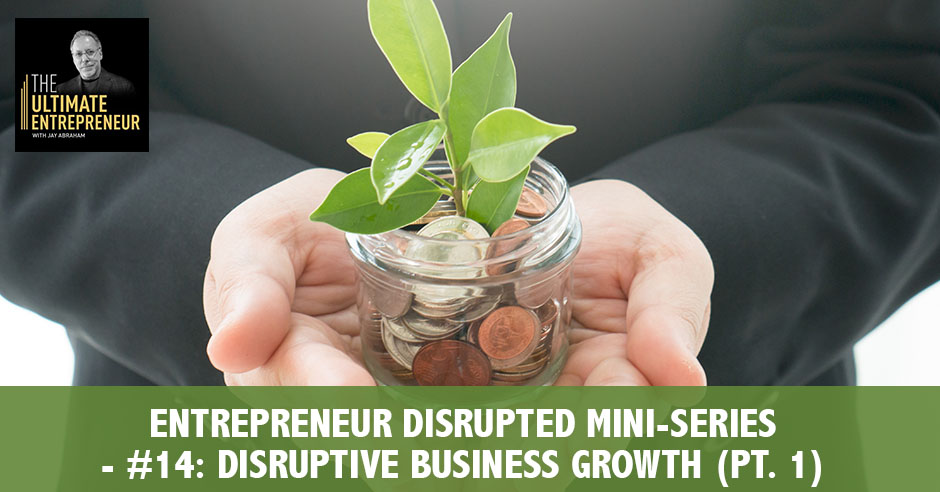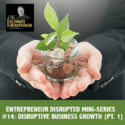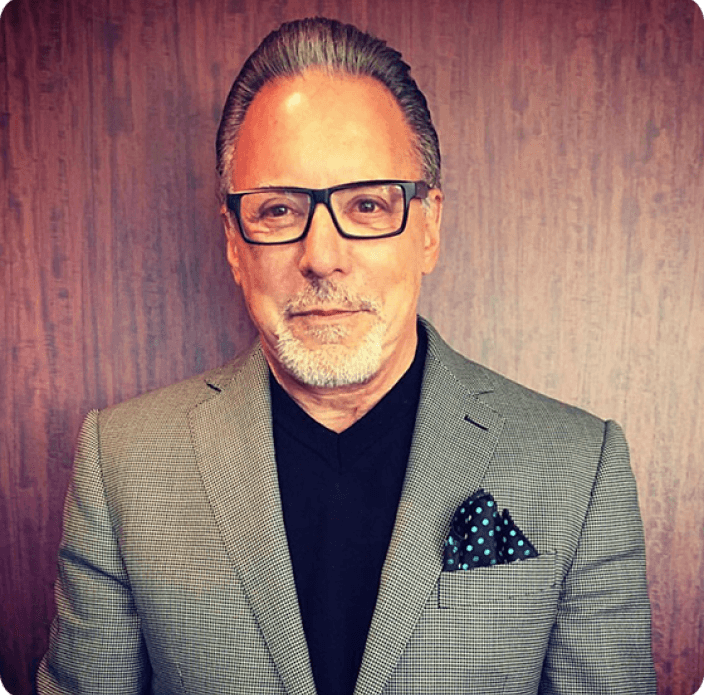
What do you do when the business you’ve worked so hard to create begins to get stuck and hits turbulence? In #14 of Entrepreneur Disrupted, Jay Abraham and Dave Asprey show how disruptive business growth can help stop your downward spiral in business. Learn more about the foundations of growing a business using the most effective methods that Jay and Dave personally use; how to get unstuck from downward growth; and how to change your worldview by connecting with a broad spectrum of people as a well-rounded entrepreneur.
Discover new philosophies on growing upside leverage, powerful referral systems, business growth drivers, and the merits of strategy vs. tactics – all backed by his own personal case studies! It’s definitely a treat for those looking to grow their business in the age of disruption.
Listen to the podcast here:
Entrepreneur Disrupted Mini-Series – #14: Disruptive Business Growth (Pt. 1)
That feeling of building a business and accomplishing what you set out to do, all that endless hustling and sleepless nights finally paying off, quite possibly, it’s one of the greatest feelings there is out there. This is where it’s only begun. What do you do when that very same amazing business begins to get stuck and hits turbulence? In this episode, that’s the very issue Dave and I are going to consider. This episode covers the foundation of growing a business, how to grow what you’re currently doing along with Dave and I’s most effective methods and personal action recommendations. I share my philosophies on, and keep in mind all of these will be backed by my own personal case studies, growing upside leverage, powerful referral systems, the most important effective business growth drivers such as the importance of testing, strategy versus tactics, powerful distinction, marketing optimization, nuggets of pure gold, discovering ways to get unstuck from downward growth, learning to be well-rounded and connect with a large spectrum of people, and most importantly, changing, expanding, evolving your own worldview. I hope you do what is essential to your own business aspirations and take meaningful action from the wisdom and advice and illustrations we’ve distilled in this episode.
We’re going to talk about the foundations of growing a business. We are assuming that you’re in business or you’re thinking of being in business. It doesn’t matter, but you’re going to want to know how to grow what you’re doing. I’ve asked Jay to come up with his 101 ideas of most important thing for growing a business. We’re going to start with him and then I’m going to talk about mine, and of course we’ll diverge and talk about cool stuff and stories throughout. All of it is there to instruct you. Jay, how do we grow?
What I would like to do is very quickly, rapidly and from a much more macro sense start with the realization and then share with you some very immutable stratagems, tactics and elements that have been used worldwide to grow any and every business I’ve ever helped. We’ll get into more specifics later. This is just to get your mind focused. I have spent my career being exposed to activities and elements that had upside leverage, meaning same cause, same time, same effort, same capital, same human capital, same opportunity costs, and same access could be multiplied many times with no additional cost per people or risk. I’m going to start with a simple review of some of the very foundations of what I call Abraham 101. These are the highest leverage-producing, upside enhancing, and multiplying factors in your business that if you change any one of them, it will make a profound difference as long as you change it better. If you change many of them, the cumulative effect will be literally doubled geometric and I’m not analytical.
I’m going to start with what I call the business drivers. Please remember, I focus on the revenue side. I focus on the positioning side. I focus on the connection with the market. I’m not a day-to-day manager. I’m going to go through a litany, a hierarchy of the most important. The first one is you change your strategy, you change your results. Most entrepreneurs, even the ones that are up to $50 million, all told our tactical. I’ve got stories that are very illustrative that tell real-life stories of how two people doing the same thing, one tactically made $5,000 from the effort and one strategically made $25 million in one year and it just takes longer to do this. There are many different kinds of strategies you can change. We also have deep explanation that we’ll give you, so you know the difference of what strategy means and why your tactic should only be used if they enhance, advance, and further what your strategic goal is. Most entrepreneurs are episodic. They are impulsive, erratic, and incongruent when they do tactical things. The first big leverage is you change your strategy or you become strategic instead of tactical, you change your results and will expand.
The second one is marketing. You change your marketing, you change your results. I’ll give you a fast litany of introductory examples. Marketing can mean the vehicles you use. Marketing can mean the proposition you use in those vehicles. Marketing can mean the position you use within either of those vehicles. Marketing can mean the way you initiate your relationship. Marketing can mean how you follow up depending on whether you’re selling something that’s immediately responsive, that’s contemplated, that’s multi-influence, but most people do not maximize their marketing and it’s not your fault. There’s no shame in not knowing, but my privilege has been to look at the highest performing marketing on a worldwide basis in literally almost 500 industries.
I had a client, we changed the first ten words on the headline on an investment ad. We did not change the rest of the ad in Wall Street Journal. We tried five different experiments. One headline change, nobody copy change, multiplied the yield of the ad 500% and it multiplied the conversion factor by more than the average order. We’ve tested ways of greeting people at the front door of stores, large furniture stores, where we tested 33 different ways besides saying, “Can I help you?” We found one way that tripled the number of conversions and enhanced the rest. We have tested different price points and it would double or triple. We have tested different ways of producing credibility or proof and it has doubled response. We have tested different ways of taking away the apprehension or the risk or the worry of making a commitment because when any two parties come together to do business or anything else, one party is also asking the other, either implicitly or explicitly, to take on all, most, or more than all the risks. More than all the risk is if you take on a Cloud-based solution that blows up and now you don’t have control of your inventory or your payables. You have to know how to mitigate that. There are alternative ways to market that are higher and better access points to where the money is.
The greatest bank robber that ever lived was a man named Willie Sutton. He robbed more banks in the ‘40s and ‘50s than anybody else. He set the record and still holds it. When they finally caught him, they asked him, “Why did you rob so many banks?” His answer was quite pragmatic, “Because that’s where the money is.” Most people don’t market where the money is. We’ll introduce you to thinkers and people who have figured out how to isolate the real buyers. Most people waste 90% or 100% of their money on markets where there’s small probability instead of figuring out either how to zero in on the right market or how to collaborate with people that already have the right market.

You can change the subject line in your email. You can change the headline on your landing page. You can change the way your telephone people greet somebody when they either call in or call out. You can change the signage on your trade show booth to one that is more benefit-oriented to the target audience. I have enormous experience with those simple seeming factors, doubling, redoubling. One of my clients in the dental community used a variation of that and he got 500 new accounts in one day when his average was ten. He said he got not only 500 new accounts, it was at a very large dental convention and ten large companies came to him wanting to do joint ventures.
Second is marketing, first is strategy, the next one is capital. Capital means a multitude of things. How do you use your money? You can use your money to buy ads. You can use it to pay for performance. You can use it to pay for experts who perform, and you pay for either the growth or the savings or the new market distribution. You can use it to invest upfront in either low-priced products that you don’t need to make money on because they are feeders for the real sale. You can invest in extraordinary products or services that you either buy for other people or give. You can invest in very innovative ways to partner with media. You can invest in starting your own media.
Many years ago, a company called Colonial Penn started out trying to create group insurance programs for affinity groups. They had all kinds of organizations and they were having a terrible time doing it because they were competing against more formidable companies. After about a year and a half of frustration, somebody said, “We’re doing this wrong. Why don’t we just create our own entity so we’ll have a captive market?” They created AARP, so they would have a market. You’ve got human capital and human capital can mean a lot of things. It can mean your talent. If you’re not a huge entrepreneur, most people don’t realize that there’s research that demonstrates that the average small to medium entrepreneur gets only 20% of the performance, the productivity and the intellectual and creative capacity of their talent. Nobody wants to be mediocre. Very few people are as lazy as you think. Very few people are as incompetent or as inattentive. If they don’t perform the way you want, is it their fault or is it your fault? There are two different paths that could be causation. One is that you hired wrong and the second is that you didn’t invest in growing and developing the ability of your people. When you have five times more performance capable of everybody you’re already paying, and you don’t invest in it, it’s tragic. Most people think they’ve been trained. Most people aren’t going to be trained in all the soft and the interactive and the collaborative skills that make people more powerful, effective, productive, collaborative and profitable.
You’ve got intellectual capital, which is like processes and procedures that you might have that upon analysis are infinitely higher performing in either productivity, cashflow management or effectiveness. You alone are utilizing and developed but could be repurposed all over. I had a company that was a masterful in a kiln drying in the lumber mill business. Kiln drying is the most expensive, most energy-utilizing capacity. It’s what turns raw timber into lumber. It’s giant ovens that are powered and they take all the energy and the biggest cost, and if done wrong, instead of double A value, they create B, C or waste. If you could figure out how to mitigate the cost and enhance the quality of the production, you accomplish two things. My client had better costs, he had higher performing qualitative gradations, and he had almost no waste, but in that business, he could have given his lumber away after 900 miles and the cost of the shipping would have made it irrelevant, so we took every lumber mill worldwide except for 900 miles and we license the technology. He made $4 million extra a year from that, which was more than he was making for the lumber mill.
The person that I helped long ago, she became the Co-CEO of Keller Williams. She was a realtor who sold her business in Oklahoma because she was put on a non-compete, and she was masterful at listing. She was ten times better at listing than anyone else, but she had a non-compete in Oklahoma. We taught her how to go all over the country and teach listing, and she made $90,000 a week. We had car wash that had an ability to get twice as many people to take the premium upsell. It was very significant. They were making like $20,000 a month, but their market was about two miles. We went to a thousand other car washers and for $200 a month, we let them use that and they were making $200,000 a month from repurposing as opposed to the $20,000 from the business. The last one, a cleaner in Chicago that had three stores. He used my stuff. His average revenue was double or triple, but he had no growth inclinations, so he went to a couple thousand dry cleaners and for $100 he repurposed. They were all outside of Chicago and has worked.
Intellectual property, how many ways can you use that? That’s another capital. The other capital is relational capital. Who do you or could you have a relationship with who either has prestige, advantage, influence, access to the market or could bring credibility to you? Relational capital could be external, finding them or internal, doing an analysis of the profile of your buyers and seeing if there is a skew that you haven’t ever concentrated on or if there are people of either generic or prominence that you’ve never recognized or if there are ethical and meaningful ways to collaboratively use their access or their distinction.
Next is your business model. One business model is you sell direct. In other business model, you sell something first or you give something first. Another business model, as a freemium. There are about a million business models and the smartest thing to do is question your business model because when I look at business models, most of them are very inefficient, ineffective, and they fail to understand what I will call the Suez Canal Strategy of Business. Anybody who’s ever learned about or travel the Suez or the Panama Canal knows that there’s two oceans. A ship cannot go diagonally up, so they have to go to one lock, raise a little bit, and another lock, raise a little bit to get to the higher altitude or the differential. Did you ever see a tugboat that’s less than one-story tall that is pulling a tanker that’s twenty stories tall? If you’ve ever seen that, you should ask yourself, “How in the world do they get a rope that is like three feet in diameter over the bow twenty stories high?” it’s impossible conceptually and the way they do it is they have a gun that shoots a relatively small cord over the bow, attached to that is a somewhat larger cord, attached to that is a somewhat larger cord, and that’s a metaphor for looking at your business model. The question that I used to use when I started my business is, “Are you unintentionally limiting, restricting, constraining your market from…?” and then you can fill in the blank. Buying more, buying more often, starting a relationship, buying more things, referring more people. Most companies are, and we can get into that as a separate product, so I’m trying to do this early business model.
Then your relationships are people that can give you leverage. You want leverage. There are two kinds of leverage. It’s like good and bad cholesterol. Too much of the bad, you’re dead. A lot of the good one compensates even for the bad one. I look only at upside leverage, which you get much higher yield for no more time, effort, expense, people, and risk. When you grasp that and you live in that world, monumental clarity and possibility become evident. I’ll get deep into relationships because I’ve done hours on it. You got access to all kinds of relationships. We’ve done as much as $2 billion in sales for a client without doing any ads, just finding other companies, other service organizations that already had access to the market, the credibility, the distribution and the trust and making them our partners.

Distribution channels and access vehicles. I believe most people limit dramatically their growth, their success, and put themselves into a very precarious position by building the majority or the totality of their revenue on one distribution channel, one marketing approach when in fact, if you create multiple ones, and we call that creating a power Parthenon, you literally can penetrate the market from many vantage points. It is like a positive Chinese water torture. You can literally reach different people with different influential credibility. We already talked about processes and procedures. There’s variability in life. I’ve been very privileged. Besides helping 300 plus of the top experts in the world in business and performance and having to learn their methodology, their ideology and philosophy, I also got the privilege of helping the Deming organization, who is the father of optimization of process improvement. I helped QualPro, which is the world’s largest multi-variable testing organization. The other one was DecisionQuest, which is the world’s largest strategic litigation consulting firm that has a couple hundred PhD sociologists and psychologists. They test everything from the differences of certain words to juries all the way to how you can depict pain and suffering, either good or bad, and graphics. I learned all those things.
Changing processes and procedures is powerful. The easiest thing to explain is that if you have a sales force, if you have distributors, if you have multiple people doing anything in the revenue-generating side, if you have franchisees, the 80/20 rule is going to apply, but there is a wonderful expansion factor. There might be twenty different elements that you’ve never looked at. I helped a very large radio chain once that had 400 stations. We’d go to their market and they’d have eight stations in a market. I would identify first of all the factors that some salesperson could excel at, like who could sell their time best? Because most radio stations sell packages, good, bad, and crappy time. Number two, who could sell against better rated radio stations? Number three, who could sell at better margins? Number four, who could sell different kinds of industries? Number five, who could sell packages that had other non-radio components built in? Number six, who could open accounts, maybe not keep them? Number seven, who’s better at keeping them and couldn’t open them?
We would isolate who they were and then we would measure how much better they were than one another. If it was only 10% or 15%, we’d find the three or four that are at that level, we would socratically interview them, and they would teach everybody how to be 10% or 15% better. If they were 300%, 400%, or 500% better, then we make them a specialist. If you’re ten times better at opening car dealers, you would open car dealers for everybody and flip them. It’s a pragmatic way of looking at consistency, performance, and ascendancy in process and procedure.
The next is your ideology. I teach outrageously powerful, non-linear, but profoundly rock solid, critical thinking-based alternative ways of communicating, reaching, projecting, articulating, denominating, personifying who you are, but if you believe it’s crap, you’re right. If you believe that is possible and it’s worthy of trying an inexpensive, safe test, knowing that every test won’t work and that’s why we asked you to read that Amazon thing. I’m all about upside leverage. I’m all about maximizing what you’re doing before you start doing other things because whatever you’re doing, even if it’s ludicrous, it’s driving your business, so you might as well get the most out of it, so it’ll free up additional windfall capital to put into more pragmatic things first before you start doing other things because there’s very few of you that even come close to maximizing all the impact points and leverage points in the revenue side.
The next is examine and evaluate. All marketing isn’t the same. All lead sources aren’t the same. All kinds of buyers aren’t the same. People buy one product might be more profitable upfront but may not buy as much of other products or as longer. Nobody knows that everybody doesn’t deserve the same investment or attention, so either over or under-investing in most of them. Funnel vision versus tunnel vision, which is looking at everything outside of your industry, so you can adapt, adopt, borrow success processes from outside your industry because you can have preeminence, preemption, and powerful advantage when you do that.
The other two things are the three ways to grow a business model. Most people don’t realize the biggest time expenditure you have is the first transaction you do with a buyer. It’s the hardest to build trust. It’s the hardest to build a profitable transaction. After you get their purchase, as long as it’s ethical, it’s easy as long as it adds value to get that transaction expanded, multiplied, make the transaction larger. It’s easy as long as it’s value-based to get them to come back more often, it’s easy whether you have enough products or not to find other complementary products to offer them. It’s easy unless it’s a very private type. If it was a surgeon doing a breast jobs, it might be harder, but with most people that are not fiercely competitive, it’s easy with proactive, strategic, systematic referrals to get lots of referrals, but nobody knows that.
One of the things that stands out from that is when you’re talking about the guy who realized licensing his technology was way more effective than running it. Most of those were very creative thinking things. Entrepreneurs are in the trenches. They do what they’re doing. I’d say 90% of entrepreneurs just keep doing it. They don’t think about those big directional changes. You and I see the world with an entrepreneurial lens where those things are blatantly obvious. For our audience who are running a business that’s stuck, how do they see those differences? How do they find that?
 First one is we created a program called The Creativity Switch and the concept is how to turn on and then turn up your creative thinking. It’s very simplistic. It starts by saying whatever you normally do or your normal protocol. You get up, you take a shower, you go to the bathroom, you have a coffee, get paper, drive on the highway. Do the opposite and be aware. It’s a cool course we sold one time and never sold again. There’s a famous book that was written in 1950, it’s called A Technique for Producing Ideas. It was written by James Webb Young. He was the Head of Creativity for J. Walter Thompson and this is in the era of magazines being prominent. He used to give ideas to all these magazines on how to package special addition. Whenever he gave them ideas, they sold out and wherever he didn’t, they didn’t. They came to him and said, “Can you help us develop how to do this?” He said there is a process, first thing is you got to realize what your brain was designed to do. Your brain was designed to solve problems and create opportunities either for you or for others, but it can’t do it unless you tell it what it’s supposed to do. It could mean you’re frustrating your brain because you’re not clear enough thinkers. Most people aren’t clear enough in grasping at a critical and verbal level what they’re trying to accomplish, and your poor brain is going, “What am I supposed to do?”
First one is we created a program called The Creativity Switch and the concept is how to turn on and then turn up your creative thinking. It’s very simplistic. It starts by saying whatever you normally do or your normal protocol. You get up, you take a shower, you go to the bathroom, you have a coffee, get paper, drive on the highway. Do the opposite and be aware. It’s a cool course we sold one time and never sold again. There’s a famous book that was written in 1950, it’s called A Technique for Producing Ideas. It was written by James Webb Young. He was the Head of Creativity for J. Walter Thompson and this is in the era of magazines being prominent. He used to give ideas to all these magazines on how to package special addition. Whenever he gave them ideas, they sold out and wherever he didn’t, they didn’t. They came to him and said, “Can you help us develop how to do this?” He said there is a process, first thing is you got to realize what your brain was designed to do. Your brain was designed to solve problems and create opportunities either for you or for others, but it can’t do it unless you tell it what it’s supposed to do. It could mean you’re frustrating your brain because you’re not clear enough thinkers. Most people aren’t clear enough in grasping at a critical and verbal level what they’re trying to accomplish, and your poor brain is going, “What am I supposed to do?”
That makes me think about my background. I talk about Cloud computing and all that. It’s the positive side of hacking but also computer security. The way my brain works and always has as a hacker works well for an entrepreneur, but I look at everything and I think, “How can I break it? How can I make it better? How can I build it differently?” The ability to know how to break something is important to know how to make it better because then you can identify a weakness that you can potentially use; a weakness in a market, a weakness in a product category or even weakness in yourself if you can spot that. That makes it easy for me to see these opportunities because they’re all weaknesses. They are all things that you can break that didn’t work very well, and you can do that better. Most people are not raised to think about breaking stuff. Are there any things I’m driving right now or could do?
I got to finish with this book because it’s got a very simple template. He said, “First thing is figure out what you’re trying to accomplish and then immerse yourself in as much dimensional data that you can.” If people are trying to compete, most people when I ask them, and I say, “Tell me what you know about your competitor. Tell me what you know their position. Tell me what you know about how they sell. Tell me what you didn’t notice it.” No one even looks at them, so you got to get as much data as you can on what you’re doing. The key is getting as much data as you can about everything else.
We used to do two things. First of all, in the beginning we’d have everybody stand up from all the industries and tell what they did, how they did it, why they did it, what the most successful thing they did that could be learned by anybody else and it would blow people’s mind. You’d see one person doing millions of dollars with a sales force and nobody else had a sales force that you need somebody else. The second thing is every time we did an explanatory segment, a two-hour segment, on something that I just did, we would have people go around their table and identify the different, specific, single, most powerful interpretation they got out of it and what they were going to do with. It’s very important. It’s substrata. No two-people’s reality is the same.
I am processing through my experiential mindset. I’ve got a canvas painting a picture. You might hear that years ago I used to do seminars and I’d come in late and say, “I just saw the most outrageous statuesque, beautiful, stunning woman out in the lobby and it deterred me.” I’d wait a minute and then I go around and ask what came to mind. Some would say, if it was a woman, it was one answer, but if it was a guy, it could be slim and flat, could be European, could be blonde, but you’d realize that there’s no two realities. That stated, try to learn as much as you can from everyone you can that’s not doing what you do. Get all your friends to give you their journals and read the ads. This is when bookstores used to exist. We would go out and we would buy as many close-out, non‑fiction books, whether it was on business, advice, hobbies, and magazines as possible. We used to have 600 to 700 people come, so we’d say, “Dave, if you have a hobby, what is it?”
I have young kids, so that’s what I tell my hobbies to other people. I’m a dad and I run Bulletproof.
If somebody said, “I love my motorcycle,” we would give him the book on macramé or we would give him a magazine on wedding planning and we’d make them go to their room and read either two chapters or two articles, come back to their table, and present two great ideas they had never learned that were fascinating and translatable. We’d go around the room and we’d pick the best one. We’d have all the tables do it. You got to figure out how to learn from others and then the next key is mastering Socratic interview.
Back when I was fifteen or sixteen, I used to work in an amusement park. I’m this overweight and awkward kid. I wasn’t very successful in dating and if you think about things from the sixteen-year-old male perspective, I’m stuck selling tickets in a ticket booth. The only magazine in there is like Young Teen Miss. I was like “I got to read something or I’m going to go nuts here,” so I started reading this and the article in there is “How to tell if a guy is flirting with you.” No teenage boy, at least back then, would ever read girl teen magazines because that’s not masculine. I read this and I’m like, “This is an instruction manual for how to hit on girls,” The next girl that walks up to buy a ticket, I’d do what it said probably awkwardly, but within a few days, I was in multiple dates. I was like, “this is amazing,” but it came about from looking at stuff that I wouldn’t do. I still do that to this day like if I’m sitting on a flight, I like to read Wired, that is my favorite magazine. I’ll read that, but I’m also going to pick up Glamour or one of those things. That is not my world, like a wedding magazine, I’d look through. The people who do those things, they are potential customers and what they want and what they care about matters. I may choose to make something for them or not, but I think that by understanding them, it makes me more well rounded and probably makes me better at running Bulletproof.
It’s a distinction, it’s a power and it’s overlooked. The more you understand the different values, the different interests, the different motivators of others who you depend on in all ways, buyers, suppliers, team members, everybody, the more powerful you are connectivity-wise.
This all comes down to assumptions. Most of the time when you see someone doing something that doesn’t make any sense to you, the answer is obvious, they’re crazy or they’re stupid or they’re irrational. When I was studying computer science, which was what I focused on for the first four years of university, it took me six years to get my four-year degree because I changed it. I was one class away from having a minor in religious studies because I found I could pad my GPA effectively, like how could you not get an A in religious studies class compared to calculus. The most interesting class in college was called Religion and Violence. It was taught by rabbinical scholar and we listened to Jim Jones. We looked at Hamas and the religious rhetoric behind very violent organizations. On the very first day of class, 50 people in there, the teacher was like, “What do all these religious groups have in common?” I said, “They’re all irrational,” and he laughed. He said, “Actually, no.” He said, “All of them are perfectly rational if you believe what they believe.” There’re core assumptions that I have about the world and pretty much all of them were wrong.

Most entrepreneurs have core assumptions about their business. If I put on my rational hat, all of the stuff in a woman’s magazine is completely irrational. It doesn’t make any sense to me. If I realize that there are different set of assumptions from people who subscribe and get those magazines every month and get value in pleasure from them, it’s not stupid. It’s not irrational, it’s just different. Understanding the thinking and the assumptions behind it lets you communicate with people in an effective way. I have a list of things that I used to grow a company, and communications is at the top of the list.
In the next episode, what we’ll do is talk about the ‘Dave perspective’ on how do you grow a company. It’s that weird knowledge of being able to figure out someone else’s assumptions about the world and then talk in a language that makes sense to them so that you can bring something of value that they may never pay attention to otherwise.
Important Links:









